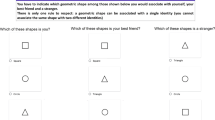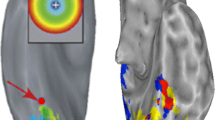Abstract
Growing evidence suggests that the underlying geometry of a visual image is an effective mechanism for conveying the affective meaning of a scene or object. Indeed, even very simple context-free geometric shapes have been shown to signal emotion. Specifically, downward-pointing V’s are perceived as threatening and curvilinear forms are perceived as pleasant. As these shapes are thought to be primitive cues for decoding emotion, we sought to assess whether they are evaluated as affective even without extended cognitive processing. Using an Implicit Association Test to examine associations between three shapes (downward- and upward-pointing triangles, circles) and pleasant, unpleasant, and neutral scenes, in two studies we found that participants were faster to categorize downward-pointing triangles as unpleasant compared to neutral or pleasant. These findings were specific to downward-pointing shapes containing an acute angle. The present findings support the hypothesis that simple geometric forms convey emotion and that this perception does not require explicit judgment.




Similar content being viewed by others
Notes
Greenwald et al. (2003) recommend using a D statistic that involves computing the difference between the compatible and incompatible blocks and dividing by the pooled variance across the two blocks. This statistic was calculated and yields identical results for the compatible compared to incompatible blocks in the present studies. For ease of interpretation the mean RTs are presented here.
References
Aronoff, J. (2006). How we recognize angry and happy emotion in people, places, and things. Cross-Cultural Research, 40, 83–105.
Aronoff, J., Barclay, A. M., & Stevenson, L. A. (1988). The recognition of threatening facial stimuli. Journal of Personality and Social Psychology, 54, 647–655.
Aronoff, J., Woike, B. A., & Hyman, L. M. (1992). Which are the stimuli in facial displays of anger and happiness? Configural bases of emotion recognition. Journal of Personality and Social Psychology, 62, 1050–1066.
Bar, M., & Neta, M. (2006). Humans prefer curved visual objects. Psychological Science, 17, 645–648.
Bar, M., & Neta, M. (2007). Visual elements of subjective preference modulate amygdala activation. Neuropsychologia, 45, 2191–2200.
Bassili, J. N. (1978). Facial motion in the perception of faces and of emotional expression. Journal of Experimental Psychology: Human Perception and Performance, 4, 373–379.
Berry, D. S., & McArthur, L. Z. (1985). Some components and consequences of a babyface. Journal of Personality and Social Psychology, 48, 312–323.
Brendl, C. M., Markman, A. B., & Messner, C. (2001). How do indirect measures of evaluation work? Evaluating the inference of prejudice in the Implicit Association Test. Journal of Personality and Social Psychology, 81, 760–773.
Center for the Study of Emotion, Attention [CSEA-NIMH]. (1999). The international affective picture system: Digitized photographs. Gainesville, FL: The Center for Research in Psychophysiology, University of Florida.
Darwin, C. (1872/1998). The expression of the emotions in man and animals (3rd ed.). New York: Oxford University Press.
De Houwer, J. (2001). A structural and process analysis of the Implicit Association Test. Journal of Experimental Social Psychology, 37, 443–451.
Eder, A. B., & Rothermund, K. (2008). When do motor behaviors (mis)match affective stimuli? An evaluative coding view of approach and avoidance reactions. Journal of Experimental Psychology: General, 137, 262–281.
Eibl-Eibesfeldt, I. (1989). Human ethology. New York: Aldine de Gruyter.
Ekman, P. (1973). Universal facial expressions in emotion. Studia Psychologica, 15, 140–147.
Ellwart, T., Rinck, M., & Becker, E. S. (2006). From fear to love: Individual différences in implicit spider associations. Emotion, 6, 18–27.
Gable, P. A., & Harmon-Jones, E. (2008). Approach-motivated positive affect reduces breadth of attention. Psychological Science, 19, 476–482.
Gast, A., & Rothermund, K. (2010). When old and frail is not the same: Dissociating category and stimulus effects in four implicit attitude measurement methods. The Quarterly Journal of Experimental Psychology, 63, 479–498.
Gawronski, B., LeBel, E. P., & Peters, K. R. (2007). What do implicit measures tell us? Scrutinizing the validity of three common assumptions. Perspectives on Psychological Science, 2, 181–193.
Greenwald, A. G., & Banaji, M. R. (1995). Implicit social cognition: Attitudes, self-esteem, and stereotypes. Journal of Personality and Social Psychology, 102, 4–27.
Greenwald, A. G., Banaji, M. R., Rudman, L. A., Farnham, S. D., Nosek, B. A., & Mellot, D. S. (2002). A unified theory of implicit attitudes, stereotypes, self-esteem, and self-concept. Psychological Review, 109, 3–25.
Greenwald, A. G., & Farnham, S. D. (2000). Using the Implicit Association Test to measure self-esteem and self-concept. Journal of Personality and Social Psychology, 79, 1022–1038.
Greenwald, A. G., McGhee, D. E., & Schwartz, J. L. K. (1998). Measuring individual differences in implicit cognition: The Implicit Association Test. Journal of Personality and Social Psychology, 74, 1464–1480.
Greenwald, A. G., Nosek, B. A., & Banaji, M. R. (2003). Understanding and using the implicit association test. I. An improved scoring algorithm. Journal of Personality and Social Psychology, 85, 197–216.
Hildebrandt, K. A., & Fitzgerald, H. E. (1979). Facial feature determinants of perceived infant attractiveness. Infant Behavior and Development, 2, 329–339.
Hildebrandt, K. A., & Fitzgerald, H. E. (1983). The infant’s physical attractiveness: Its effect on bonding and attachment. Infant Mental Health Journal, 4, 3–12.
Karpinski, A., & Hilton, J. L. (2001). Attitudes and the implicit association test. Journal of Personality and Social Psychology, 81, 774–788.
Lang, P. J., Bradley, M. M., & Cuthbert, B. N. (1999). International affective picture system: Technical manual and affective ratings. Gainesville, FL: The Center for Research in Psychophysiology, University of Florida.
Larson, C. L., Aronoff, J., Sarinopoulos, I. C., & Zhu, D. C. (2009). Recognizing threat: Simple geometric shapes activate neural circuitry underlying threat detection. Journal of Cognitive Neuroscience, 21, 1523–1535.
Larson, C. L., Aronoff, J., & Stearns, J. (2007). The shape of threat: Simple geometric forms evoke rapid and sustained capture of attention. Emotion, 7, 526–534.
LeDoux, J. E. (1996). The emotional brain: The mysterious underpinnings of emotional life. New York: Simon & Schuster.
LoBue, V., & Larson, C. L. (2010). What makes an angry face look so… angry? Examining the shape of threat in children and adults. Visual Cognition, 18, 1165–1178.
Lorenz, K. (1943). Die angeborenen Formen möglicher Erfahrung [The innate forms of potential experience]. Zeitschrift fur Tierpsychologie, 5, 233–519.
Meier, B. P., & Robinson, M. D. (2004). Why the sunny side is up: Associations between affect and vertical position. Psychological Science, 15, 243–247.
Mierke, J., & Klauer, K. C. (2001). Implicit association measurement with the IAT: Evidence for effects of executive control processes. Zeitschrift fur Experimentelle Psychologie, 48, 107–122.
Mierke, J., & Klauer, K. C. (2003). Method-specific variance in the Implicit Association Test. Journal of Personality and Social Psychology, 85, 1180–1192.
Öhman, A. E., & Mineka, S. (2001). Fears, phobias, and preparedness: Toward an evolved module of fear and fear learning. Psychological Science, 108, 438–522.
Phelps, E. A., & LeDoux, J. E. (2005). Contributions of the amygdala to emotion processing: From animal models to human behavior. Neuron, 48, 175–187.
Rothermund, K., Teige-Mocigemba, S., Gast, A., & Wentura, D. (2009). Eliminating the influence of recoding in the Implicit Association Test: The Recoding-Free Implicit Association Test (IATRF). Quarterly Journal of Experimental Psychology, 62, 84–98.
Rothermund, K., & Wentura, D. (2004). Underlying processes in the Implicit Association Test: Dissociating salience from associations. Journal of Experimental Psychology: General, 133, 139–165.
Schubö, A., Gendolla, G. H. E., Meinecke, C., & Abele, A. E. (2006). Detecting emotional faces and features in a visual search paradigm: Are faces special? Emotion, 6, 246–256.
Sherman, G. D., Haidt, J., & Coan, J. A. (2009). Viewing cute images increases behavioral carefulness. Emotion, 9, 282–286.
Stanley, D., Phelps, E., & Banaji, M. (2008). The neural basis of implicit attitudes. Psychological Science, 17, 164–170.
Sternglanz, S. H., Gray, J. L., & Murakami, M. (1977). Adult preferences for infantile facial features: An ethological approach. Animal Behavior, 25, 108–115.
Tipples, J., Atkinson, A. P., & Young, A. W. (2002). The eyebrow frown: A salient social signal. Emotion, 2, 288–296.
Trut, L. (2005). Early canid domestication: The farm-fox experiment. In P. W. Sherman & J. Alcock (Eds.), Exploring animal behavior: Readings from the American Scientist (4th ed., pp. 181–190). Sunderland, MA: Sinauer Associates.
Watson, D. G., Blagrove, E., Evans, C., & Moore, L. (2011). Negative triangles: Simple geometric shapes convey emotional valence. Emotion. doi:10.1037/a0024495.
Watson, D. G., Blagrove, E., & Selwood, S. (in press). Emotional triangles: A test of emotion-based attentional capture by simple geometric shapes. Cognition and Emotion.
Wilson, T. D., Lindsey, S., & Schooler, T. Y. (2000). A model of dual attitudes. Psychological Review, 107, 101–126.
Witterbrink, B., & Schwarz, N. (Eds.). (2007). Implicit measures of attitudes. New York: Guilford Press.
Zebrowitz, L. A. (1997). Reading faces. Boulder, CO: Westview.
Zebrowitz, L. A., & Montepare, J. M. (1992). Impressions of babyfaced individuals across the lifespan. Developmental Psychology, 28, 1143–1152.
Acknowledgments
We wish to thank Molly Barton, and Lorri Kais for their assistance. All authors affiliated with the Department of Psychology. Correspondence concerning this article should be addressed to: Christine L. Larson, University of Wisconsin—Milwaukee, Department of Psychology, 2441 E. Hartford Avenue, Milwaukee, WI 53211. Electronic mail may be sent to larsoncl@uwm.edu.
Author information
Authors and Affiliations
Corresponding author
Rights and permissions
About this article
Cite this article
Larson, C.L., Aronoff, J. & Steuer, E.L. Simple geometric shapes are implicitly associated with affective value. Motiv Emot 36, 404–413 (2012). https://doi.org/10.1007/s11031-011-9249-2
Published:
Issue Date:
DOI: https://doi.org/10.1007/s11031-011-9249-2




